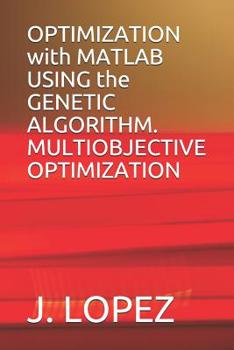OPTIMIZATION with MATLAB USING the GENETIC ALGORITHM. MULTIOBJECTIVE OPTIMIZATION
Global Optimization Toolbox provides functions that search for global solutions to problems that contain multiple maxima or minima. Toolbox solvers include surrogate, pattern search, genetic algorithm, particle swarm, simulated annealing, multi start, and global search. The genetic algorithm is a method for solving both constrained and unconstrained optimization problems that is based on natural selection, the process that drives biological evolution. The genetic algorithm repeatedly modifies a population of individual solutions. At each step, the genetic algorithm selects individuals at random from the current population to be parents and uses them to produce the children for the next generation. Over successive generations, the population "evolves" toward an optimal solution. You can apply the genetic algorithm to solve a variety of optimization problems that are not well suited for standard optimization algorithms, including problems in which the objective function is discontinuous, nondifferentiable, stochastic, or highly nonlinear. The genetic algorithm can address problems of mixed integer programming, where some components are restricted to be integer-valued.A surrogate is a function that approximates an objective function. The surrogate is useful because it takes little time to evaluate. So, for example, to search for a point that minimizes an objective function, simply evaluate the surrogate on thousands of points, and take the best value as an approximation to the minimizer of the objective function. Surrogate optimization is best suited to time-consuming objective functions. The objective function need not be smooth, but the algorithm works best when the objective function is continuous. Surrogate optimization attempts to fin a global minimum of an objective function using few objective function evaluations. To do so, the algorithm tries to balance the optimization process between two goals: exploration and speed.Simulated annealing is a method for solving unconstrained and bound-constrained optimization problems. The method models the physical process of heating a material and then slowly lowering the temperature to decrease defects, thus minimizing the system energy. At each iteration of the simulated annealing algorithm, a new point is randomly generated. The distance of the new point from the current point, or the extent of the search, is based on a probability distribution with a scale proportional to the temperature. The algorithm accepts all new points that lower the objective, but also, with a certain probability, points that raise the objective. By accepting points that raise the objective, the algorithm avoids being trapped in local minima, and is able to explore globally for more possible solutions. An annealing schedule is selected to systematically decrease the temperature as the algorithm proceeds. As the temperature decreases, the algorithm reduces the extent of its search to converge to a minimum.
Format:Paperback
Language:English
ISBN:1076750451
ISBN13:9781076750457
Release Date:January 1
Publisher:Independently Published
Length:380 Pages
Weight:1.47 lbs.
Dimensions:0.8" x 6.0" x 9.0"
Customer Reviews
0 rating





